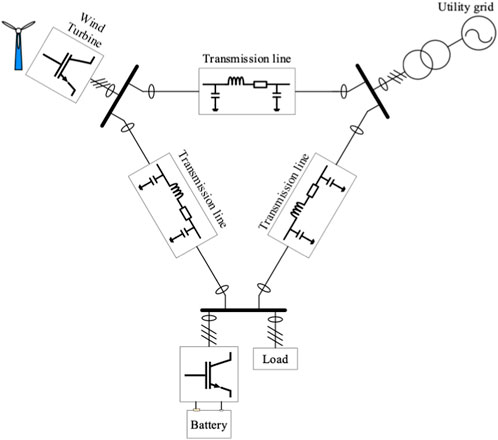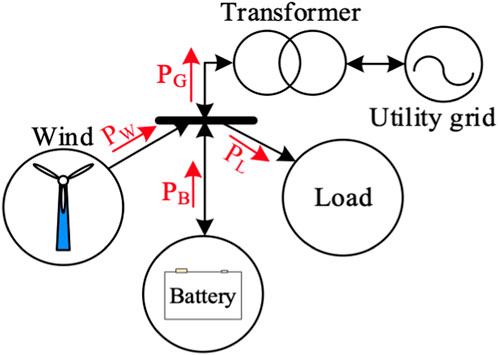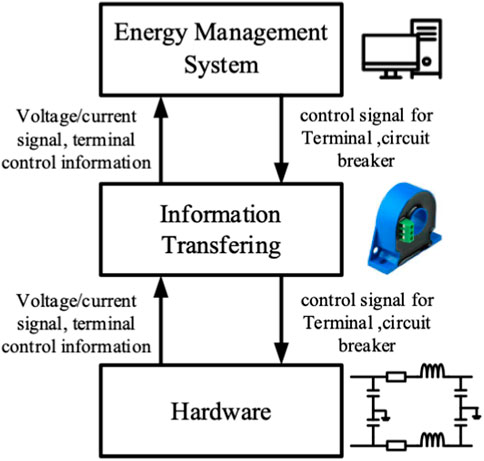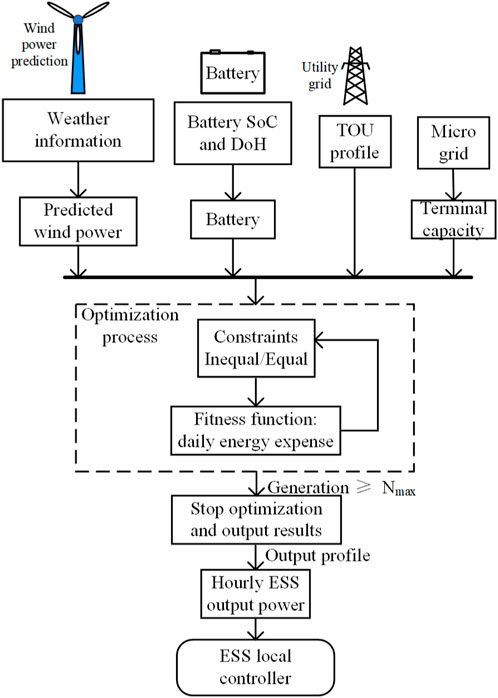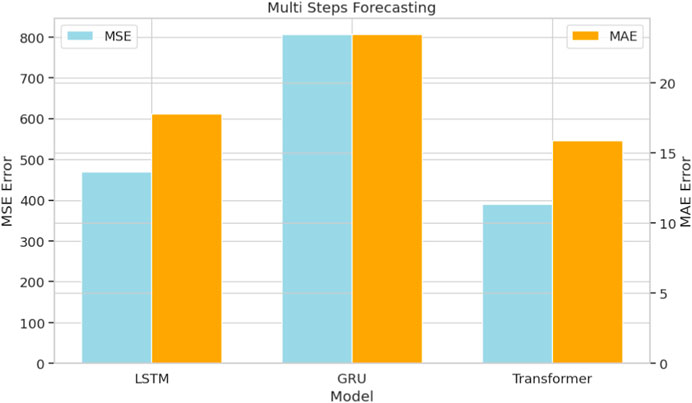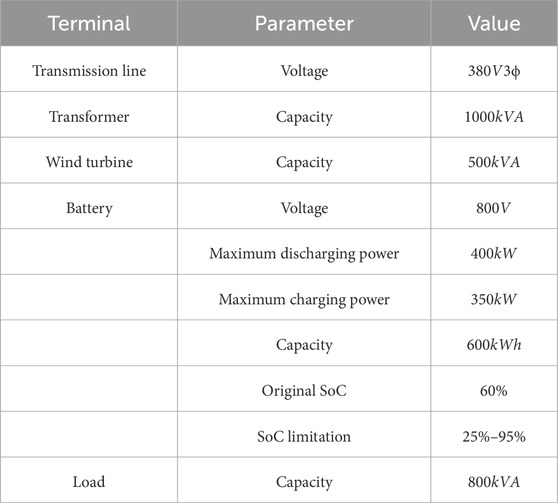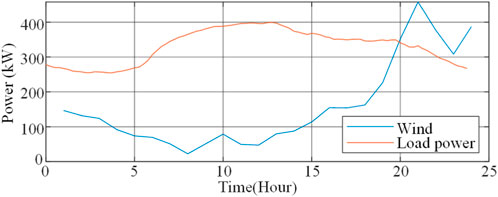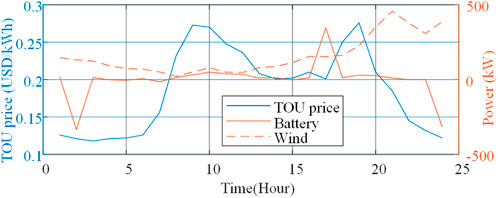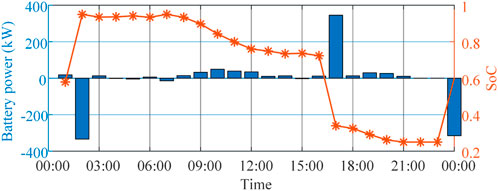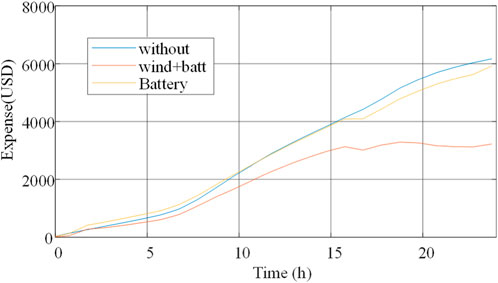- 1Electric Power Research Institute, State Grid Anhui Electric Power Co., Ltd., Hefei, Anhui, China
- 2School of Electrical Engineering and Automation, Anhui University, Hefei, Anhui, China
- 3School of Electrical Engineering and Automation, Hefei University of Technology, Hefei, Anhui, China
Microgrid has been extensively applied in the modern power system as a supplementary mode for the distributed energy resources. The microgrid with wind energy is usually vulnerable to the intermittence and uncertainty of the wind energy. To increase the robustness of the microgrid, the energy storage system (ESS) is necessary to compensate the power imbalance between the power supply and the load. To further maximize the economic efficiency of the system, the system level control for the microgrid is desired to be optimized when it is integrated with the utility grid. Aiming at the aforementioned problem, this paper comprehensively analyzes the power flow of a typical loop microgrid. A transformer-based wind power prediction (WPP) algorithm is proposed and compared with recurrent neural networks algorithm. With the historical weather data, it can accurately predict the 24 h average wind energy. Based on the predicted wind energy and the time-of-use (TOU) electricity price, a day-ahead daily cycling profile of the ESS with particle swarm optimization algorithm is introduced. It comprehensively considers the system capacity constraints and the battery degree of health. The functionality of the proposed energy management strategy is validated from three levels. First, WPP is conducted with the proposed algorithm and the true historical weather data. It has validated the accuracy of the transformer algorithm in prediction of the hourly level wind energy. Second, with the predicted wind energy, a case study is given to validate the day-ahead daily cycling profile. A typical 1 MVA microgrid is utilized as the simulation model to validate performance of the daily cycling optimization algorithm. The case study results show that the ESS daily cycling can effectively reduce the daily energy expense and help to shave the peak power demand in the grid.
1 Introduction
The renewable energy such as photovoltaic and wind energy has multiple superiorities including zero carbon emission and reduced generation cost over conventional power Byers and Botterud (2020). However, they also pose challenges to the modern power system due to their distributed characteristics. The modern power system is based on concentrated load and generationCady et al. (2015). The increasing proportion of the distributed generations (DGs) is challenging for the power dispatching and operating efficiency improvement. Thus, microgrid is an emerging supplementary power generation mode to address the challenge posed by the increasing penetration of distributed energy resources in the modern power system Zhao et al. (2017).
Among all renewable energy resources, wind energy has the advantage of cost-effectiveness which makes it appropriate for areas with rich wind energy resources such as off shore areas Tessarolo et al. (2017). However, its intrinsic intermittence features make it undesired for power grid operation. This problem is particularly serious in weak grid conditions such as microgrid which has lower capacity than the large power grid. The mismatch between the power generation and load can lead to wind curtailment which is detrimental to increasing the operating efficiency Zhao et al. (2016). In the worst case, it raises multiple power quality concerns such as frequency deviation or voltage flickering and finally operating failures.
To address the problems posed by wind energy in the microgrid, considerable research effort has gone into the power industry which includes the following steps. The development of battery technology enables energy storage systems (ESS) in the microgrid to reach higher capacity with reduced cost. There are various types of ESS such as the lithium-ion (Li-ion) battery, flywheel, lead-acid batter, etc. Prakash et al. (2022). Li-ion battery has been extensively applied in the EVs for the sake of its large energy density and relatively mature manufacturing technology Deng (2015). Therefore, some microgrids also utilize recycled Li-ion batteries as the ESS unit. A large ESS with a fast dynamic response speed can greatly shave the peak generating power and fill the load demand. The energy storage system for microgrid generally includes battery packs and power conversion systems. Via adjusting the output power of the PCS, the power in the grid can be changed and the bus voltage is maintained. However, the application of ESS introduces extra cost for the microgrid and its cycling can lead to aging of the battery. Using ESS daily cycling to minimize the power expense is emerging recently Zhao et al. (2019). The Time-of-Use (TOU) price of the electricity varies hour by hour because of the load changes hourly. Accordingly, when the microgrid is tied to the utility grid, the ESS charges when the TOU price is low and discharges when TOU price is high. For the microgrid, due to the capacity limitation, the daily optimization algorithm of the ESS can be different.
Another effort is developing more accurate wind power prediction (WPP) algorithms. The application of emerging artificial intelligence algorithms enables wind energy models to be more complex and accurate with data-driven methods Zhao et al. (2017). An accurate wind energy prediction strategy is essential for the day-ahead optimization of the microgrid operation plan. Based on the optimization operation plan, the energy management system of the microgrid can effectively adjust the output power of the ESS and DG to minimize the generated power curtailmentYang et al. (2014). The existing WPP algorithms are usually based on recurrent neural networks (RNN) models or the improved RNN models such as short-term memory and gated recurrent units. However, RNN-based models process data sequentially instead of in parallel which makes it struggle with long-range dependencies, and under-perform with non-stationary time-series data. Transformers, which is renowned in natural language processing and image tasks, are now capturing the interest of time series researchers. They show great performance at handling global information while predefined cutoff lengths is not needed. It shows great promise in capturing long-range dependencies, particularly in recent time series prediction tasks Sun et al. (2021). As an emerging algorithm, the industry application of transformer-based model still has large space for further development.
Aiming at addressing the aforementioned problems, this paper introduces a kind of daily optimization method of the microgrid with wind energy generation and ESS. Considering the TOU price, the ESS operates in daily cycling mode to maximize the saving for the users. A machine-learning-based WPP algorithm is introduced. It employs the local historical wind energy data to train the algorithm. Compared with the widely used time-series WPP methods, the proposed energy management strategy utilizes transformer-based algorithm to process the weather data. Compared with the conventional RNN-based methods, its parallel data processing feature makes it more appropriate for the day-ahead hourly-level WPP since the operating efficiency is increased. Also, With the prediction results, a day-ahead operation plan of the ESS cycling which considers the battery aging is introduced with Particle Swarm Optimization (PSO). Simulation results experimental results have validated the functionality of the proposed forecast algorithm and the energy management strategy.
The other sections of this paper are organized in the following way: Section 1 summarizes the state-of-the-art WPP algorithm and the energy management strategy for the microgrid. Section 2 analyzes the microgrid power flow, introduces the proposed WPP method, and the TOU price profile. Based on the predicted wind energy profile and local TOU price profile, Section 4 introduces the day-ahead optimization algorithm of the microgrid and the ESS with PSO. Section 5 introduces a case study to validate the functionality of the proposed energy management strategy. Conclusions are drawn in Section 6.
2 Related work
Microgrid is proposed for various applications to connect the distributed generation resources, loads and ESSs. Since it was first introduced in Hatziargyriou et al. (2007), both industry and academia have dedicated much effort to improving the control and structure of the microgrid to increase its robustness under various operating conditions. The structure of the microgrid, such as the terminal can be different based on the application scenarios. Generally, the energy management of the microgrid can be categorized into three types: hierarchical control Zhao et al. (2016), autonomous control Pogaku et al. (2007), and master-slave control Xie et al. (2021). The power flow control of the microgrid is conducted via changing the operating modes of the power converters. Tayab et al. (2017) introduces the droop control for the microgrid. Rosso et al. (2021) introduce the grid-forming converter for the DGs inside the microgrid. The targets of microgrid energy management can be concluded into two aspects: maximize the economic efficiency and improve the system operating stability. Improving the economic efficiency can be implemented via shaving the peak power demand and filling the valley demand. Therefore, the TOU price is employed by the utility companies to assist in the power dispatching. Yang et al. (2012) employ game-theory to optimize the TOU pricing and maximize the benefit for the utility grid.
Compared with the conventional large grid, microgrid is usually more vulnerable to the uncertainties of the DGs due to the limited system capacity Shuai et al. (2016). Among all distributed energy resources, wind and solar energy occupy the dominant penetration in the current renewable energy structure. Compared with solar energy, wind energy is more efficient. However, wind energy has the intrinsic characteristics of uncertainties and intermittence which are detrimental to the robust operation of the microgrid Wood (2020). As summarized in Xue et al. (2014), there are two major reasons for wind energy uncertainties: average wind speed in the long term and fluctuating wind speed in the short term.
The integration of wind energy brings about multiple concerns for the microgrid such as frequency fluctuation and voltage flickering. To minimize its impact on the microgrid frequency and the voltage, Gautam et al. (2010) propose a blade pitch angle compensation control method and Qi and Tsuji (2023) introduce a time-series coordinated frequency control strategy for the wind farm. It can also result in low-frequency oscillation in the doubly fed induction generators. Therefore, Yang et al. (2011) propose a model to explain the mechanism and figures out the potential solutions. Apart from the microgrid robustness, it can also affect the carbon emission Yao et al. (2012), electricity market Ghadikolaei et al. (2012) etc.
To minimize the downsides brought by wind energy integration, various methods are proposed to control and optimize the system’s energy management. The extensively applied methods include wind power prediction (WPP) Rodríguez et al. (2020), wind farm system-level control Andersson et al. (2021), fault ride-through Zhang et al. (2020), and energy storage. Among the aforementioned four method, using ESS is the only hardware-based method. The capacity of ESS is highly associated with the robustness of the microgrid. Liu et al. (2018) utilize particle swarm optimization (PSO) algorithm to determine the capacity of a hybrid ESS.
Compared with the other methods, WPP can be assisted in making power dispatching plan to optimize the system operation in advance. With the increasing penetration of wind energy in the current energy structure, WPP becomes more significant since it provides theoretical basis to the comprehensive grid operating optimization. Both academia and industry have dedicated numerical effort into the research of WPP. As a critical part of the numerical weather forecast (NWF), WPP utilizes the wind speed and wind direction predicted with NWP as the input data. However, due to the different locations of each wind turbine, the NWP results cannot be directly employed to replace WPP. Also, the mutual impact between wind turbines can also lead to prediction errors. For instance, the wind turbine at the front side can generate a wake flow which will affect the operation of the following wind turbines []. Therefore, an accurate WPP model should incorporate the physical model of the wind turbines.
Due to the intermittency and uncertainty of wind, WPP is always challenging particularly for a single wind turbine. Generally, WPP can be categorized into two types: short-term prediction which aims at the time-scale shorter than 24-h Sanchez (2006), and long-term prediction which aims at the time-scale longer than 24-h Ahmadi et al. (2020). For the short-term prediction, the wind speed variance and disturbance increase as the prediction period increases due to the inertial of wind power fluctuation. The error of short-term prediction varies due to the intermittence and inertia of the wind turbine which is highly associated with location, environment, and the predicted time. Due to the prediction errors, the post-processing of the prediction results is usually necessary Zhao et al. (2022b). Various methodologies are employed for the short-term WPP such as the Markov chain, Kalman filter, etc. Li et al. (2001) propose a first-order artificial neural network model to estimate the very short-term wind turbine power curve. Blonbou (2011) introduces an artificial neural network model with adaptive Bayesian earning and Gaussian process approximation for short-term prediction. Senjyu et al. (2006) introduce a recurrent neural network algorithm to conduct the long-term-ahead wind power generation profile.
According to the aforementioned literature review investigation, this paper will introduce a comprehensive optimization algorithm for the loop microgrid with wind energy and ESS. The WPP is conducted with transformer which shows superiority over the conventional algorithms such as long short-term memory (LSTM) and recurrent neural networks (RNNs). Also, particle swarm optimization algorithm is utilized to make the daily cycling plan for the battery which comprehensively considers the constraints of the system capacity.
3 Microgrid system topology introduction
3.1 Three-terminal microgrid system introduction
A typical three-terminal loop microgrid is given in Figure 1. It includes a wind energy generation terminal, a battery ESS, a load bank and utility grid. The battery ESS is usually located close to the load to compensate for the load demand. The ESS consists of a battery bank and a bidirectional power converter. An transformer is employed to connect the microgrid and the utility grid. Different terminals are connected via transmission line. The bus voltage is set to be 220 V ac. The transmission cable is three-phase four-line. Generally, the transmission cables have circuit breakers on the line.
It can be operated under islanding mode and grid-connected mode. Islanding mode occurs when the utility grid is no longer accessible. The top-priority target of the islanding mode is to minimize the power outage time and maximize the system’s robustness. In contrast, when the utility grid is available, the energy management system will aim at maximizing the operating efficiency.
Generally, due to the generation intermittence of DG and the missing of a large grid, only a wind energy terminal as the power source is not enough for a microgrid in islanding mode. To maintain the power balance, as many types of DGs as possible such as photovoltaic energy, bioenergy, and tidal energy should be employed for a microgrid. Also, the energy storage system can operate in grid-forming mode to maintain the bus voltage.
In the grid-connected mode, the robustness of the microgrid can be supported by the utility grid and it is no longer the major concern. Thus, the operating efficiency is the top priority target for the microgrid. It can be conducted by minimizing the wind energy curtailment and daily cycling of the ESS to benefit from the TOU price. This paper focuses on the grid-connected mode of the microgrid. The control of the microgrid in grid-connected mode can be found in Figure 2.
The power flow analysis is essential for operation optimization. Figure 2 shows the power flow of the microgrid. The wind energy generation system and the load are all unidirectional while the transformer and the battery are bidirectional. PB, PW, PL and PG denote the output power of the battery, wind energy generation terminal, load, and the grid. The reference direction of each variable is marked in Figure 2.
The energy management strategy of the microgrid is hierarchical control which includes three layers as shown in Figure 3. The hardware layer include all physical components such as the transmission line, the converter, the connectors, etc. The local control of the power converter is also in the hardware layer. The information transferring layer plays a key role in the information exchange between the system layer and the hardware layer. It delivers the local information such as the power flow, voltage or current to the energy management system while the control signals are sent to the hardware layer. The energy management system controls the whole microgrid and dispatches the power flow in the grid. It should be noted that the day-ahead optimization is performed in the energy management system.
3.2 Prediction of the wind power
In 2019, wind energy played a substantial role in advancing renewable energy, contributing to one-third of the overall growth Wood (2020). While the evolution of wind power technology brings evident economic and environmental benefits, the integration of large-scale wind power into the grid faces challenges due to its intermittent nature. WPP emerges as a pivotal solution to tackle this issue.
As demonstrated in Section 2, WPP can be categorized based on the time frame of predictions: ultra-short-term (0–4 h) for managing intraday operations, short-term (typically 1 day or a few days in advance) for day-ahead planning and unit commitment, and medium/long-term forecasting (spanning weekly, seasonal, annual, or more) for wind resource assessment and selection of wind farm sites.
WPP methodologies can be broadly classified into four primary categories: physical models, statistical approaches, intelligent systems, and hybrid methods as shown in Figure 4. Predictions can also be categorized based on the types of input features they use, such as multi-variable predictions and historical predictions. This research, in particular, focuses on intelligent, short-term historical predictions. For the wind prediction task, the prediction process is defined in Eq. 1.
where
In this study, a transformer model is employed for the prediction task. The encoder component takes the historical time series as input, while the decoder predicts future values in an auto-regressive manner. To establish a connection between the encoder and the decoder, an attention mechanism is employed. This allows the decoder to learn how to prioritize the most pertinent historical values from the time series before making a prediction. Furthermore, the decoder utilizes masked self-attention to prevent the model from gaining an unfair advantage during training by peeking ahead and using future data to predict past values. Note that the prediction can inevitably introduce the prediction errors. Therefore, it is recommended to incorporate the prediction error correction algorithm in prior to performing optimization for the system. Some post-processing algorithms for wind energy prediction can be found by Jiang and Huang (2017) and Zhao et al. (2022b).
3.3 Time-of-use price
The utility company employs the TOU price profile to assist in shaving the peak demand the filling the valley. The price of the energy changes hourly based on the demand. A typical TOU pricing profile is given in Figure 5. Generally, the price is higher at the peak demand time while it decreases at the valley demand time. The customers will adjust their usage of electricity accordingly to minimize their daily energy expense. For instance, the charging of electric vehicles can be delayed to midnight when the TOU price is low. In this case, the power of midnight in the utility grid can be slightly increased and the operation efficiency is improved. Also, the utility company does not need to invest more money into the construction of backup capacity.
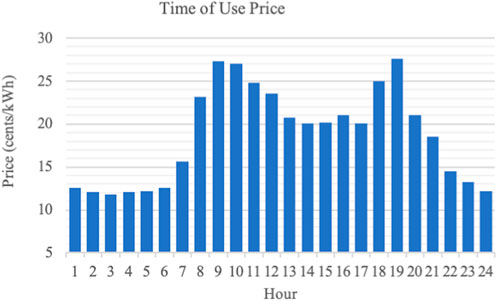
FIGURE 5. A typical TOU price profile (Own representation of data from www.epexspot.com).
4 Day-ahead ESS cycling plan
4.1 Object function and optimization constraint
The optimization object which is improved on the basis of the proposed algorithm in Zhao et al. (2019) aims to minimize the total energy expense of the microgrid which is usually a community network. As mentioned earlier, via charging the battery when TOU is low and discharging the battery when TOU is high, it can maximize the operation efficiency for the customers. Therefore, the object function as shown in 2 is the part the changed expense caused by the ESS daily cycling. It should be noted that in this paper, the power loss on the transmission line can be ignored due to the small size of microgrid.
Herein, PB(N) and TOU(N) denote the output power of the ESS and the Time-of-Use price at the hour-N. Since the load is determined by the users and it is independent of the system-level control, the only considered variable is ESS output power. The optimization should follow multiple constraints such as the SoC of the battery, the maximum power limit of each terminal and the SoC daily cycling constraints which can be expressed in 3 - 5.
In 3, the output power of the battery is limited to the maximum power rating for charging and discharging. In 4, there is a limitation for the battery SoC. When SoC is too high, the battery is over-charged and it can damage the hardware. In contrast, SoC is also not desired to be very low since deep discharging can lead to a shortened lifetime of the battery. Therefore, it is desired to limit the battery SoC to be within an appropriate range to prevent the over charge/discharge damaging the battery. Usually, SoClow which is the lower limit is between 20% and 40% and SoChigh which is the upper limit should be lower than 95%.
SoC(N) denotes the SoC of the battery at the end of hour-N. To finish a completed charging cycle, it is needed to make the SoC same level after completing a daily cycle. In other words, after the charging/discharging for a day, the SoC should return to the initial point, i.e., SoC (initial) in the equation. The SoC of the battery at the end of each 30 min can be calculated with 6. Herein, the loss on the power converter is neglected since it is usually very low. Currently, the efficiency of a power converter with wide bandgap semiconductor devices can go to 98% Zhao et al. (2022a). To make the SoC prediction more accurate, it is usually necessary to consider the power loss of the power converter. In this case, the output power of the converter should be multiplied by the efficiency.
In 6, SoC(N) is the SoC at the end of hour-N in a day. SoC (0) is the initial SoC of a day. The SoC (0) can be assumed to be 60% at 0:00 a.m. since 60% is the recommended SoC to maintain the battery lifetime. Note that, due to the battery aging in the daily cycling, the capacity fading should be considered in this case. DoH denotes the battery degree of health which should be measured daily to avoid SoC estimation errors. It can be conducted using an offline method with a coulombmeter as given in Yang et al. (2018). CB is the nominal battery capacity and VB denote the battery output voltage. Also, due to the limitation of the transformer capacity, the wind power, load and the battery output power should follow the constraint as given in 7. It can avoid the curtailment of the wind energy caused by the extra-large ESS output power.
4.2 The optimization algorithm process of ESS output power
The optimization flow is shown in Figure 6. Usually, the optimization process should be performed a day ahead.
All information including the predicted wind power, ESS specs and status, TOU profile from the utility company, and the microgrid parameters is input to the optimization process as the original data. Based on the given data, the fitness function as given in Eq. 2 and the constraints as given in Eqs 3–7 can be determined. Then the optimization can be performed. The selection of various optimization algorithms such genetic algorithm, PSO, simulated annealing algorithm, etc., depends on the application scanario. To avoid the calculation results being trapped into the local optimal point, the initial conditions and maximum iteration generation should be carefully selected. After iteration, the optimized ESS output power can be generated and it will be utilized as the reference value for the ESS converter P/Q control scheme.
5 Experimental study
5.1 Wind power prediction results
In this segment, we utilize actual wind power data to assess the efficacy of forecasting strategies based on transformer models. The data, generated by the Weather Research and Forecasting (WRF) model, consists of hourly samples, amassing a total of 8,640 data points. For our analysis, we consider a historical sequence of 10 samples to predict future wind power output. The dataset is partitioned into a training set comprising 70% of the data, and a testing set making up the remaining 30%. We employ LSTM, GRU, and transformer models to conduct both single-step and multi-step predictions. In single-step forecasting, the immediate next data point is predicted, while in multi-step forecasting, the prediction is made for the third data point in the sequence.
The experiments are conducted on a Linux PC equipped with an AMD Ryzen 5 3550H processor, clocked at 2.1 GHz, along with 16 GB of RAM. The computational environment includes Python 3.9 and TensorFlow 2.8.0. Our aim is to validate the effectiveness of the proposed forecasting approach. TensorFlow is employed due to its ability to handle large datasets and perform complex computations efficiently. It is very appropriate for the evaluation of model accuracy and its deployment for practical, real-time forecasting application. The performance of each model is assessed using two metrics: Mean Squared Error (MSE) and Mean Absolute Error (MAE). MSE quantifies the average squared deviation between the predicted and actual values, offering insight into the model’s precision. Conversely, MAE calculates the average absolute discrepancy between the predicted and actual values, showcasing the extent of deviation in the model’s predictions.
Upon conducting a thorough analysis of the experimental results in Figures Figure 7, Figure 8, Figure 9, Figure 10, it is observed that the transformer model exhibits superior performance in comparison to the LSTM and GRU models in both single-step and multi-step forecasting tasks. The transformer model demonstrates comparable proficiency to the LSTM model, and maintaining an advantage over the GRU model. These empirical findings underscore the transformer model’s potential as an efficacious approach for time series forecasting in wind power prediction endeavors.
5.2 Optimization results: a case study
A case study is given in this paper to validate the functionality of the proposed algorithm. A 500 kVA microgrid system is utilized for the case study. The specs of the microgrid are listed in Table 1.
The hour-level predicted wind power from the original data and the load profile can be plotted in Figure 11. After all data such as the wind energy generation, TOU price, load profile, and the constraints are determined, the optimization process can be performed. In this paper, PSO is employed. The optimization results of the battery output power are plotted in Figures 12, 13.
From Figures 12, 13, the battery output power matches the TOU price. When the TOU price is high, the battery output power increases. When the TOU price is low, the battery charges. From Figure 7, the battery SoC is also within the set constraint 25% and 95%.
The daily expense of the microgrid is plotted in Figure 14. From Figure 14, without the wind energy and the battery daily cycling, the daily energy expense is 6,138 dollar. The ESS daily cycling can reduce the energy expense by 188 dollar. If a larger battery bank is utilized, the cost reduced by daily cycling can be larger. With wind energy and the battery, the total daily cost of energy can be reduced to 3,200 dollar. Therefore, the DG terminal and ESS can effectively reduce the user energy cost.
6 Discussion
To maximize the advantages of microgrid using wind power and battery ESS, this paper proposes a kind of system-level control strategy and the ESS daily cycling algorithm. Using WPP results and the TOU price, it can effectively reduce the daily energy expense and help the utility grid to dispatch energy by shaving the peak demand. The experimental study is conducted in two levels and the results are discussed as below.
6.1 WPP results
A transformer-based WPP algorithm is proposed and compared with the state-of-the-art machine learning algorithms. From the comparison results as given in Figure 7 - 8, all machine learning methods can predict the wind power at hourly level. However, among the listed algorithms, the transformer algorithm shows superiority over the LSTM and GRU model. The MSE error of the transformer algorithm in single-step prediction is much better than LSTM and GRU model. For multi-step prediction, the GRU model still have the largest MSE error. The MSE error of transformer algorithm is slightly lower than LSTM. Therefore, for 24 h WPP, transformer can be a suitable algorithm.
6.2 ESS daily cycling optimization
From the simulation study in last section, the daily cycling of the ESS can effectively reduce the electricity expense of the users. The charging time focuses at 1:00-3:00 when the TOU is the lowest during a day. The discharging time is usually between 15:00-18:00 when the TOU is highest. It should be noted that it also charges at 23:00 since the battery SoC should return to 60% at the beginning of a daily operating cycle. The simulation results also reveal that the majority of saved expense is still from the wind energy which has no cost. The daily cycling has lower benefit per day. However, for 2 years, the daily cycling of ESS can cover the cost of the battery lifetime aging. Also, it should be noted that in the simulation study, PSO is employed. To achieve better optimization results, other optimization algorithms such as GA, grey wolf optimizer, etc., can be tried.
7 Conclusion
In this paper, a system level control strategy is proposed for the loop microgrid with wind energy generation terminal and the ESS. As the theoretical basis for the system-level operation strategy optimization, a transformer-based WPP algorithm is proposed and compared with LSTM. The comparison results reveal that transformer-based model has better prediction results over the conventional time-series algorithm. With the predicted wind power profile, the ESS daily cycling plan is made based on the optimization algorithm with TOU price. PSO is utilized for the ESS optimization. The case study shows that for a 1MVA microgrid with 800 kVA regular load, the daily cycling of a 400 kVA 600 kWh ESS can reduce the daily energy expense by 3%. Thus, the proposed energy management strategy can effectively improve the system operating efficiency.
Data availability statement
The raw data supporting the conclusion of this article will be made available by the authors, without undue reservation.
Author contributions
BX: Conceptualization, Writing–original draft, Writing–review and editing. FZ: Software, Validation, Writing–review and editing. RB: Data curation, Software, Validation, Writing–review and editing. HS: Data curation, Formal Analysis, Resources, Software, Writing–original draft, Writing–review and editing. SD: Project administration, Resources, Supervision, Writing–review and editing.
Funding
The author(s) declare financial support was received for the research, authorship, and/or publication of this article. This work was funded partially by the State Grid Anhui Electric Power Co., Ltd. Scientific and Technology Project (No. 5212G0230002).
Conflict of interest
Authors BX, FZ, and HS were employed by State Grid Anhui Electric Power Co., Ltd.
The remaining authors declare that the research was conducted in the absence of any commercial or financial relationships that could be construed as a potential conflict of interest.
Publisher’s note
All claims expressed in this article are solely those of the authors and do not necessarily represent those of their affiliated organizations, or those of the publisher, the editors and the reviewers. Any product that may be evaluated in this article, or claim that may be made by its manufacturer, is not guaranteed or endorsed by the publisher.
References
Ahmadi, A., Nabipour, M., Mohammadi-Ivatloo, B., Amani, A. M., Rho, S., and Piran, M. J. (2020). Long-term wind power forecasting using tree-based learning algorithms. IEEE Access 8, 151511–151522. doi:10.1109/access.2020.3017442
Andersson, L. E., Anaya-Lara, O., Tande, J. O., Merz, K. O., and Imsland, L. (2021). Wind farm control-part i: a review on control system concepts and structures. IET Renew. power Gener. 15, 2085–2108. doi:10.1049/rpg2.12160
Blonbou, R. (2011). Very short-term wind power forecasting with neural networks and adaptive bayesian learning. Renew. Energy 36, 1118–1124. doi:10.1016/j.renene.2010.08.026
Byers, C., and Botterud, A. (2020). Additional capacity value from synergy of variable renewable energy and energy storage. IEEE Trans. Sustain. Energy 11, 1106–1109. doi:10.1109/TSTE.2019.2940421
Cady, S. T., Domínguez-García, A. D., and Hadjicostis, C. N. (2015). A distributed generation control architecture for islanded ac microgrids. IEEE Trans. Control Syst. Technol. 23, 1717–1735. doi:10.1109/TCST.2014.2381601
Deng, D. (2015). Li-ion batteries: basics, progress, and challenges. Energy Sci. Eng. 3, 385–418. doi:10.1002/ese3.95
Gautam, D., Goel, L., Ayyanar, R., Vittal, V., and Harbour, T. (2010). Control strategy to mitigate the impact of reduced inertia due to doubly fed induction generators on large power systems. IEEE Trans. power Syst. 26, 214–224. doi:10.1109/tpwrs.2010.2051690
Ghadikolaei, H. M., Ahmadi, A., Aghaei, J., and Najafi, M. (2012). Risk constrained self-scheduling of hydro/wind units for short term electricity markets considering intermittency and uncertainty. Renew. Sustain. Energy Rev. 16, 4734–4743. doi:10.1016/j.rser.2012.04.019
Hatziargyriou, N., Asano, H., Iravani, R., and Marnay, C. (2007). Microgrids. IEEE Power Energy Mag. 5, 78–94. doi:10.1109/MPAE.2007.376583
Jiang, Y., and Huang, G. (2017). Short-term wind speed prediction: hybrid of ensemble empirical mode decomposition, feature selection and error correction. Energy Convers. Manag. 144, 340–350. doi:10.1016/j.enconman.2017.04.064
Li, S., Wunsch, D. C., O’Hair, E., and Giesselmann, M. G. (2001). Comparative analysis of regression and artificial neural network models for wind turbine power curve estimation. J. Sol. Energy Eng. 123, 327–332. doi:10.1115/1.1413216
Liu, Z., Chen, Y., Zhuo, R., and Jia, H. (2018). Energy storage capacity optimization for autonomy microgrid considering chp and ev scheduling. Appl. Energy 210, 1113–1125. doi:10.1016/j.apenergy.2017.07.002
Pogaku, N., Prodanovic, M., and Green, T. C. (2007). Modeling, analysis and testing of autonomous operation of an inverter-based microgrid. IEEE Trans. Power Electron. 22, 613–625. doi:10.1109/TPEL.2006.890003
Prakash, K., Ali, M., Siddique, M. N. I., Chand, A. A., Kumar, N. M., Dong, D., et al. (2022). A review of battery energy storage systems for ancillary services in distribution grids: current status, challenges and future directions. Front. Energy Res. 10, 4831–4842. doi:10.3389/fenrg.2022.971704
Qi, J., and Tsuji, T. (2023). A coordinated frequency control in microgrid based on asymmetric synthetic inertia considering rotational speed of wind turbine. IEEJ Trans. Electr. Electron. Eng. 18, 525–536. doi:10.1002/tee.23763
Rodríguez, F., Florez-Tapia, A. M., Fontán, L., and Galarza, A. (2020). Very short-term wind power density forecasting through artificial neural networks for microgrid control. Renew. energy 145, 1517–1527. doi:10.1016/j.renene.2019.07.067
Rosso, R., Wang, X., Liserre, M., Lu, X., and Engelken, S. (2021). Grid-forming converters: control approaches, grid-synchronization, and future trends—a review. IEEE Open J. Industry Appl. 2, 93–109. doi:10.1109/ojia.2021.3074028
Sanchez, I. (2006). Short-term prediction of wind energy production. Int. J. Forecast. 22, 43–56. doi:10.1016/j.ijforecast.2005.05.003
Senjyu, T., Yona, A., Urasaki, N., and Funabashi, T. (2006). “Application of recurrent neural network to long-term-ahead generating power forecasting for wind power generator,” in IEEE PES power systems conference and exposition, USA, JUNE 27, 2022 (IEEE), 1260. –1265.
Shuai, Z., Sun, Y., Shen, Z. J., Tian, W., Tu, C., Li, Y., et al. (2016). Microgrid stability: classification and a review. Renew. Sustain. Energy Rev. 58, 167–179. doi:10.1016/j.rser.2015.12.201
Sun, Z., Cao, S., Yang, Y., and Kitani, K. M. (2021). “Rethinking transformer-based set prediction for object detection,” in Proceedings of the IEEE/CVF international conference on computer vision, China, 11-17 Oct. 2021 (IEEE), 3611–3620.
Tayab, U. B., Roslan, M. A. B., Hwai, L. J., and Kashif, M. (2017). A review of droop control techniques for microgrid. Renew. Sustain. Energy Rev. 76, 717–727. doi:10.1016/j.rser.2017.03.028
Tessarolo, A., Luise, F., Pieri, S., Benedetti, A., Bortolozzi, M., and De Martin, M. (2017). Design for manufacturability of an off-shore direct-drive wind generator: an insight into additional loss prediction and mitigation. IEEE Trans. Industry Appl. 53, 4831–4842. doi:10.1109/TIA.2017.2700285
Wood, D. (2020). Grand challenges in wind energy research. Front. Energy Res. 8, 624646. doi:10.3389/fenrg.2020.624646
Xie, X., Quan, X., Wu, Z., Cao, X., Dou, X., and Hu, Q. (2021). Adaptive master-slave control strategy for medium voltage dc distribution systems based on a novel nonlinear droop controller. IEEE Trans. Smart Grid 12, 4765–4777. doi:10.1109/tsg.2021.3104413
Xue, Y., Lei, X., Xue, F., Yu, C., Dong, Z., Wen, F., et al. (2014). A review on impacts of wind power uncertainties on power systems. Proc. CSEE 34, 5029–5040. doi:10.13334/j.0258-8013.pcsee.2014.29.004
Yang, H.-T., Huang, C.-M., Huang, Y.-C., and Pai, Y.-S. (2014). A weather-based hybrid method for 1-day ahead hourly forecasting of pv power output. IEEE Trans. Sustain. Energy 5, 917–926. doi:10.1109/TSTE.2014.2313600
Yang, L., Xu, Z., Østergaard, J., Dong, Z. Y., Wong, K. P., and Ma, X. (2011). Oscillatory stability and eigenvalue sensitivity analysis of a dfig wind turbine system. IEEE Trans. Energy Convers. 26, 328–339. doi:10.1109/tec.2010.2091130
Yang, P., Tang, G., and Nehorai, A. (2012). A game-theoretic approach for optimal time-of-use electricity pricing. IEEE Trans. Power Syst. 28, 884–892. doi:10.1109/tpwrs.2012.2207134
Yang, Z., Patil, D., and Fahimi, B. (2018). Online estimation of capacity fade and power fade of lithium-ion batteries based on input–output response technique. IEEE Trans. Transp. Electrification 4, 147–156. doi:10.1109/TTE.2017.2775801
Yao, F., Dong, Z. Y., Meng, K., Xu, Z., Iu, H. H.-C., and Wong, K. P. (2012). Quantum-inspired particle swarm optimization for power system operations considering wind power uncertainty and carbon tax in Australia. IEEE Trans. industrial Inf. 8, 880–888. doi:10.1109/tii.2012.2210431
Zhang, T., Yao, J., Sun, P., Pei, J., Zhang, H., Liu, K., et al. (2020). Improved continuous fault ride through control strategy of dfig-based wind turbine during commutation failure in the lcc-hvdc transmission system. IEEE Trans. Power Electron. 36, 459–473. doi:10.1109/tpel.2020.3000515
Zhao, S., Kempitiya, A., Chou, W. T., Palija, V., and Bonfiglio, C. (2022a). Variable dc-link voltage llc resonant dc/dc converter with wide bandgap power devices. IEEE Trans. Industry Appl. 58, 2965–2977. doi:10.1109/tia.2022.3151867
Zhao, S., Umuhoza, J., Zhang, Y., Moquin, J., Farnell, C., and Mantooth, H. A. (2017). “Analysis and optimization of a high-efficiency residential energy harvesting system with dual half-bridge converter,” in IEEE Applied Power Electronics Conference and Exposition (APEC), USA, 15 Jul 2021 (APEC), 2838. –2844. doi:10.1109/APEC.2017.7931100
Zhao, S., Zhang, Y., Moquin, J., and Mantooth, H. A. (2016). “The hierarchical energy management control for residential energy harvesting system,” in IEEE Energy Conversion Congress and Exposition (ECCE), China, October 29 2011 (IEEE). 1–7. doi:10.1109/ECCE.2016.7855501
Zhao, S., Zhao, X., Farnell, C., Mantooth, H. A., Umuhoza, J., and Zhang, Y. (2019). “A daily optimization method for a pv-battery microgrid considering the battery lifetime and time-of-use pricing,” in IEEE Applied Power Electronics Conference and Exposition (APEC), USA, February 25-29, 2024 (APEC), 3243. –3250. doi:10.1109/APEC.2019.8722088
Keywords: wind power prediction, optimization, microgrid, energy storage system, time-of-use price
Citation: Xu B, Zhang F, Bai R, Sun H and Ding S (2024) The energy management strategy of a loop microgrid with wind energy prediction and energy storage system day-ahead optimization. Front. Energy Res. 11:1334588. doi: 10.3389/fenrg.2023.1334588
Received: 07 November 2023; Accepted: 26 December 2023;
Published: 23 January 2024.
Edited by:
Xun Shen, Osaka University, JapanReviewed by:
Boyu Wang, Pensacola State College, United StatesYuheng Wu, John Deere, United States
Xingchen Zhao, Virginia Tech, Blacksburg, United States in collaboration with reviewer [YW]
Copyright © 2024 Xu, Zhang, Bai, Sun and Ding. This is an open-access article distributed under the terms of the Creative Commons Attribution License (CC BY). The use, distribution or reproduction in other forums is permitted, provided the original author(s) and the copyright owner(s) are credited and that the original publication in this journal is cited, in accordance with accepted academic practice. No use, distribution or reproduction is permitted which does not comply with these terms.
*Correspondence: Hui Sun, c3VuaHVpMTk5MEBnbWFpbC5jb20=
 Bin Xu1,2
Bin Xu1,2 Hui Sun
Hui Sun